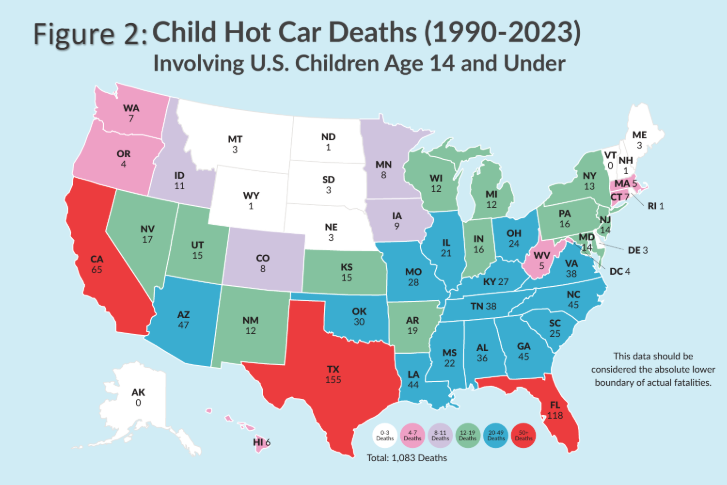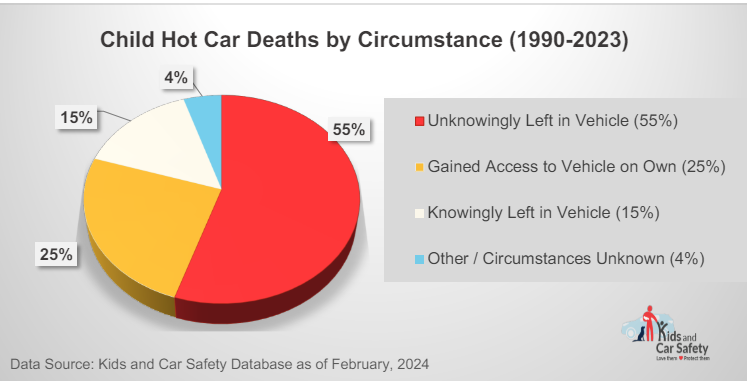Kids and Car Safety (KACS), is the nation's leading nonprofit organization dedicated to preventing nontraffic-related motor vehicle fatalities and injuries to children. The organization has published a comprehensive report detailing the incidence and circumstances of child hot car deaths in the United States from 1990 to 2023. This comprehensive analysis, based on data meticulously gathered and compiled for the KACS national database, highlights ongoing risks and emphasizes the urgent need for preventive measures and policy initiatives.

The report reveals that since 1990, 1,084 children have tragically died in hot cars, including one fatality this year. The trend in deaths has been rising, with 2018 and 2019 marking the worst years on record, with 54 and 53 child fatalities, respectively.
Most hot car deaths happen under three circumstances: children are unknowingly left in vehicles (55%), gain access to the vehicle on their own (25%), or are knowingly left in the vehicle (15%). Tragically, 88% of children who die in hot cars are age 3 and younger.
The report identifies Texas, Florida, California, Arizona, and Louisiana as the top five states with the highest number of child hot car deaths, primarily because these warmer Southern states experience higher average temperatures.
Most hot car deaths occur at temperatures of 80 degrees Fahrenheit or above. However, Kids and Car Safety notes that hot car fatalities can occur in cooler conditions too, with over 100 deaths recorded below 80 degrees, including six incidents where the outside temperature was in the 50s.?
May through September are the months at the highest risk for hot car tragedies. Cases, where children are unknowingly left in vehicles, occur most frequently towards the end of the workweek, while incidents where children gain access to vehicles on their own are more common over the weekend.

The report also examines the legal outcomes in hot car fatalities which vary significantly from case to case even under similar circumstances. It finds that approximately 43% of hot car deaths result in no charges being filed, while 32% lead to a criminal conviction or plea deal. The organization emphasizes that criminalizing these tragedies is not preventative and advocates for solutions centered on awareness, education, and technological interventions. ?
"Every nine days, a child in the United States dies from vehicular heatstroke," stated Janette Fennell, president of Kids and Car Safety. "These incidents are not due to neglect or irresponsibility; they are tragic accidents that devastate families. Our report reveals that the most common scenario involves a loving, caring parent or caregiver who simply forgets a child in the car. Understanding the who, what, when, and why these tragedies occur is crucial for prevention."
The data used in the report comes from the Kids and Car Safety organization, which has been maintaining a national database on hot car deaths and injuries to children for decades. This report is necessary due to the lack of specific coding in police reports, medical records, coroner reports, and other sources, which means that hot car deaths and injuries are not tracked through traditional vehicle-related data systems.
For decades, Kids and Car Safety has been conducting educational initiatives to raise public awareness and share information on how to prevent hot car deaths. These efforts include community outreach, the distribution of updated safety materials, and making available online resources.
By illuminating the facts and dispelling misconceptions, Kids and Car Safety furthers its mission to ensure no child dies from being left unattended in a vehicle. Join us in spreading awareness and implementing preventive measures to safeguard our most vulnerable. Together, we can put an end to these preventable tragedies.
Additional Info:
Hot Car Fact Sheet & Safety Tips
Hot Car In-Depth Fatality Report
